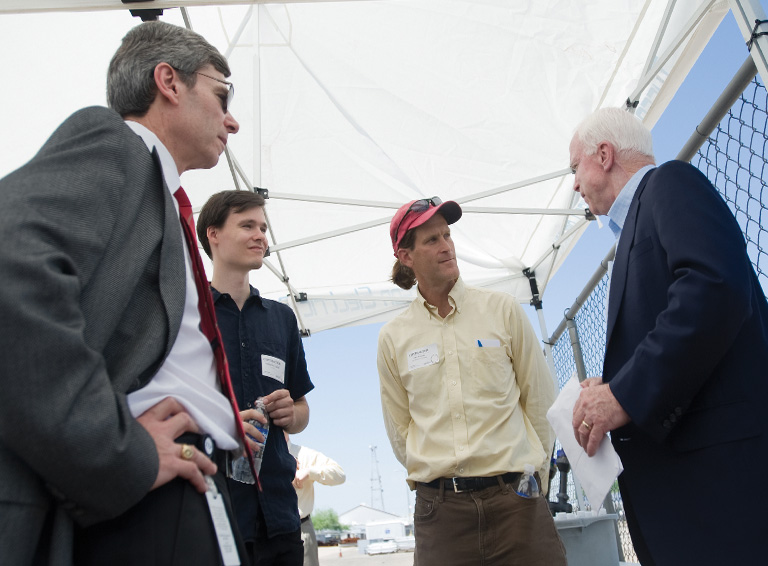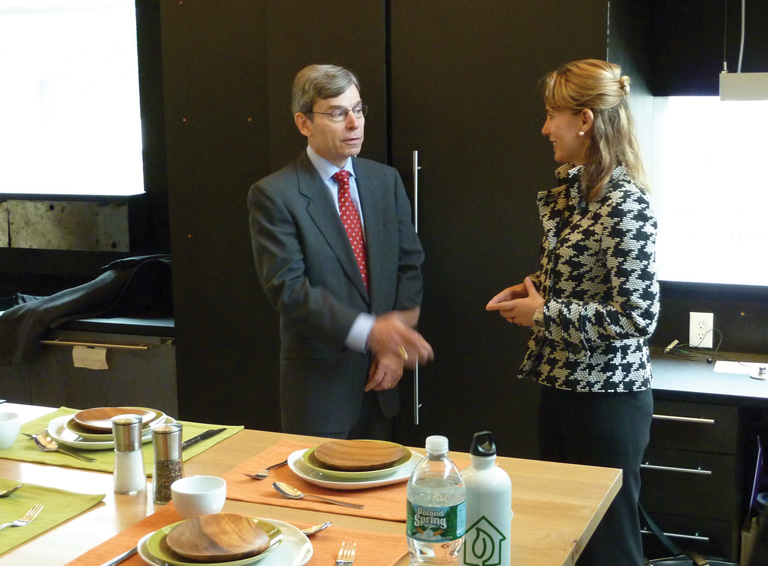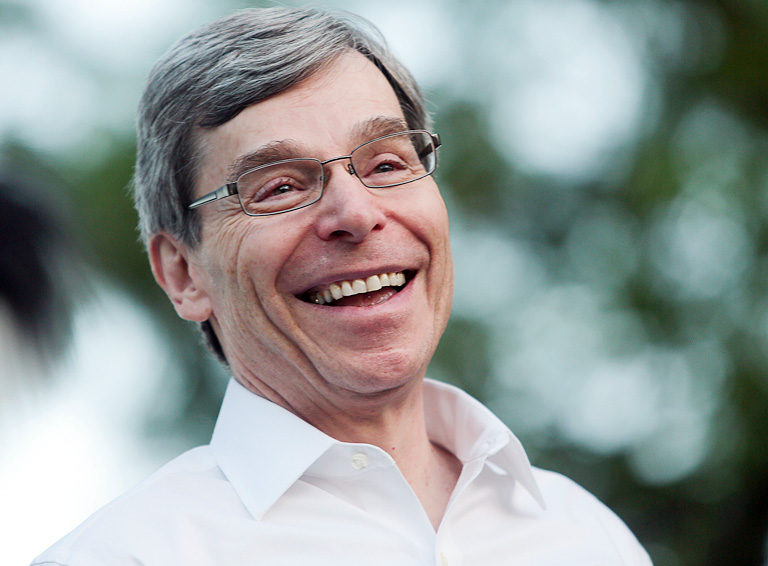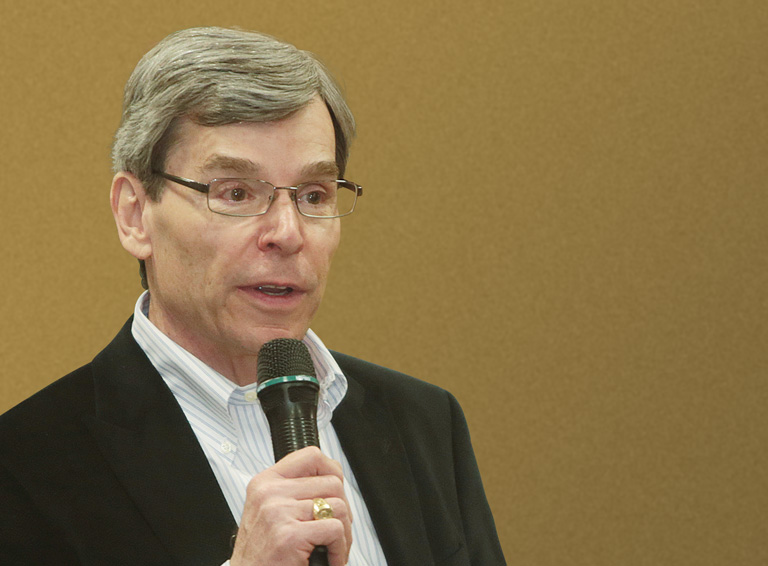Leadership Lyceum Podcast: A Conversation with Paul Bonavia
Tom Linquist is a partner at a leading global executive search firm. He is an expert on executive assessment and leadership development, and can be reached at Linquist@LeadershipLyceum.com.



The Illinois General Assembly passed a resolution designating April 1 as “Cheap Trick Day” in Illinois back in 2007. Last month I sat down with Paul Bonavia, who in his younger days was in bands with members who would go on to form Cheap Trick.
Paul’s rock and roll avocation gave way to his vocation as CEO of an investor-owned utility. Paul is better known today as the retired Chairman and CEO of UNS Energy (Tucson Electric Power). The company was sold to Fortis in August 2014.
We’ll explore the triggers and interconnected events that led to remarkable levels of consolidation in our industry.
Paul joined UNS in 2009, and in August of 2014 closed on the sale of UNS to Fortis. Fortis, Canada’s largest investor-owned gas and electric utility holding company, has been active and acquisitive. It was formed in 1987 with about three hundred ninety million dollars in assets, and it’s grown to over forty-seven billion today.
Fortis acquired three publicly-traded U.S. companies over the last several years. In June 2013, Fortis acquired Central Hudson in Poughkeepsie, New York for 1.5 billion. In August 2014, the company acquired UNS for 4.3 billion. Tucson Electric Power, the UNS utility, serves four hundred seventeen thousand customers in the greater metropolitan Tucson area. In October 2016, Fortis purchased ITC, a Novi, Michigan-based, publicly-traded transmission operator and developer, for 11.3 billion.
Tom Linquist: Fortis has been part of a remarkable trend. Twenty-five years ago, there were in excess of one hundred independent utilities. Now there are less than fifty. What is compelling the rapid pace of consolidation in the industry?
Paul Bonavia: Independent utility numbers continue to dwindle as more transactions are announced. The trend will likely continue.
The utility business has changed so much since I was first associated with the industry in the tumultuous 70s, as a lawyer representing a large utility.
That was the beginning of the big era of change, because up until then it had been all about growth. Then came the events of the 70s that had macroeconomic consequences, like economic stagnation and double-digit inflation. You had the oil crisis, which was catastrophic, especially for an oil-fired utility when oil went from five to forty dollars per barrel.
Suddenly utilities found themselves in a rising unit cost environment – not a declining one. Consequently, for probably the first time since Samuel Insull in the 1910s or 20s, sales forecasts were revised downward.
Management faced the grim prospect of few sales to cover immense capital outlays like the nuclear power plant project that many had commenced. Without a fuel adjustment clause, rising fuel costs put earnings in further jeopardy.
With the clause, the burden of costs was felt deeply by the customers, which only added pressure on sales. In this industry, when your customers are hurting, so are you.
At that point in the 70s, the industry began to say, “The sky is falling.” The industry went on an unsuccessful diversification spree in the 80s. Many went into independent power in the 90s. For the most part, that didn’t go very well. Trading came along.
Tom Linquist: And international investments.
Paul Bonavia: Right. I spent a lot of time on international in prior jobs.
There’s been a continuing series of issues and major focus areas in each of those times, which all looked scary to utilities. In those days they weren’t really accustomed to those sort of shocks.
Into the twenty-first century, the economy was pretty stable, at least up until 2008. Fuel prices were relatively manageable, and capital was relatively available. But then the real change happened. The biggest driver of consolidation and all other forms of change affecting utilities, which was technology.
New technology became so economically viable, it changed electricity consumption. Prior to this period, it had been all about changing the way you generate electricity.
Nuclear caused a major shift in the industry, as did combined-cycle natural gas and efficient combustion turbines. Then, all of a sudden, consumers could use new tools to change the way they consume electricity.
People got more energy efficient appliances. It doesn’t seem like some huge dramatic development, but with all the new efficient models, you really saw a difference in usage per customer.
Tom Linquist: Was that impact expected by the industry?
Paul Bonavia: Well, after I got into Tucson, in the first year we decided to build a new headquarters building in downtown Tucson. The company had been on the edge of town at a power plant site, not very visible or attractive to professionals. We made a commitment to downtown. The city loved it, as did our employees.
During the planning process with architects, constructors and engineers, they brought alternatives for lighting the building. Lighting can represent up to fifty percent of the energy consumption of a commercial building. LED lighting was recommended. This was in 2009, and LED was still pretty new. I realized if we can do this in our building, what’s everybody else doing?
Most in the industry thought oil shocks and changes in environmental policy, water intake and mercury rules and all that was big change. It’s not really. Those are all just, in effect, business as usual.
You just do your same business somewhat differently. But the availability of commercial, economically-viable technology that reduces consumption – that’s a game changer.
When you’re a utility, big or small, you’re going to need to keep investing because of all these environmental rules and smart grid and all the things customers want.
You’re going to keep going to the capital markets, you’re going to keep going to the rate commission if you’re regulated, and most everybody is regulated for transmission and distribution, if not generation.
Rates are going to go up. But usage is going down. Now your rate phenomenon only accelerates what technology has enabled, and what customers are waking up to. And that’s a scary prospect.
The changes in the way electricity is generated have put a lot of pressure on utilities and created a lot of risk. But the changes in the way electricity is consumed are even more profound.
If you’re part of the management or the board of a utility, your job is to look to the future. The real competition that I think drives consolidation is not necessarily the prospect that the legislature might create a competitive supply business.
Utilities have dealt with that pretty well. The real competition is the LED light bulb, the efficient appliance, the Internet of Things, the Nest thermostat, and all the things technology enables in order to reduce consumption. That’s competition.
Tom Linquist: It’s going to continue to drive volumes or usage down, and force you to cut costs per unit and continue to cut.
Paul Bonavia: Yes. Which is really hard to do.
Tom Linquist: You face limits to what you can cut.
Paul Bonavia: You can only cut so much, and you still have to maintain your service and you still have to keep your regulator satisfied. The worst scenario is to embarrass your regulators, because that never bodes well, obviously.
You’re the utility. You need them to see you as a force for good, as a force to help. There’s just a lot of pressures out there that fundamentally change the business.
Tom Linquist: Is consolidation the biggest pressure relief valve for the squeeze that’s taking place?
Paul Bonavia: When people see troubling developments, they start thinking, “Maybe we need friends here, partners or bulk.” So, there’s a psychological component.
But you can’t let that govern your thinking. You have to step back and say, “We’ve been doing pretty well. Times are always challenging. Let’s not do this for some unquantifiable gut reaction to developments.” That leads you to evaluating what can consolidation really do that’s more verifiable.
Tom Linquist: Back when you were looking at your strategic alternatives, what were you thinking as a smaller, regionally focused utility?
Paul Bonavia: In our case, we were not looking to sell the company. That was never in the plan. We worked hard in our strategy, and we liked our stand-alone prospects.
The company had been very down back in the 80s and 90s, was a junk credit with regulatory, finance, and community relations problems. But we’d been recovering steadily since then.
When I arrived in 2009, we were not where we wanted to be, but had a very effective platform. When I left, we were an investment grade credit, trading at a very healthy multiple.
We didn’t feel any pressure to do a transaction. We didn’t feel it was our future or principal mode of creating value. But when an opportunity comes along that provides greater comfort over the stand-alone case, creates more value and eliminates a lot of risk, it has to be explored.
Tom Linquist: What did you begin to learn in terms of those components as you engaged in discussions?
Paul Bonavia: Let me backtrack. I came from the outside to UNS. The board had done their homework on me before they made me an offer. I had done a lot of management and acquisition in previous jobs and as an advisor.
I told them, “I don’t think this company is a management and acquisition candidate. You still have a lot of work to do to get this company to a trading multiple, credit rating, community perception, and regulatory credibility. Let’s just focus on the company. Someday, we’ll be an attractive candidate.”
For several years, we listened to inquiries politely, because our basic determination was, we’re fiduciaries. But none of them rang the bell.
Tom Linquist: Did the board have some experience with management and acquisitions prior to your arrival?
Paul Bonavia: Yes, our company had a failed deal, prior to my arrival, about ten years before the Fortis transaction.
Tom Linquist: Was that with KKR?
Paul Bonavia: Yes, the company agreed to sell to KKR. That went before the Arizona Corporation Commission and was turned down. It left a very bad residue.
When you embark on a transaction like that, even if you’ve got some kind of breakup fee, it’s expensive. Most importantly you take your eye off the ball strategically. You just can’t help but get focused on the transaction because it requires a huge commitment of resources to the process.
That came unglued rather publicly and spectacularly. Years later, when I came on the scene, there were still directors from the era who would be a very hard sell.
Tom Linquist: So, in the meantime you focused on operational and financial improvements and building credibility with the commission.
Paul Bonavia: We’d get the occasional inquiry and it was all going along well. And then I read about Fortis in the trade press.
Tom Linquist: Around the Central Hudson announcement?
Paul Bonavia: Before that, probably 2012 or so.
Stan Marshall was the CEO, the current CEO, Barry Perry’s predecessor. In the most engaging, disarming, Canadian way, he would come to the Edison Electric Institute where we all do presentations at the financial conference, and he’d make a presentation and say, “Well, we’re the biggest utility in Canada, but if we’re going to be a major North American utility, that’s got to be the U.S. So, for all of you listening, if you’re interested, here’s my phone number.” It was a very direct approach. Not a predatory approach – actually just the opposite.
In our first meeting, he said something along the lines of, “We like to do acquisitions, but we’re not bottom feeders. We’re not looking for broken things where we can squeeze some costs out.
We want healthy companies with good prospects. We’re smart enough to know we have to pay what the company is worth, but we don’t overpay. And we talk to partners by invitation only.
You’ll never get a bear hug letter. You’ll never get any pressure from us. If you want to talk, great, here’s my phone number, here’s my business card. Call me. If you don’t, nice meeting you.”
That was their presentation. I thought, “What a charming and refreshing approach, kind of a Canadian way to be.” It works, because they’ve been very successful.
Tom Linquist: Paul, there’s a protocol you follow when you get that call. But what do you have to do in executive session when you’re going to make the call?
Paul Bonavia: Well, this evolved in an interesting way. While Fortis was still in the general, “We’d like to buy a company” mode – I think this was even before Central Hudson – an investment banker, as will commonly happen, called me. It was somebody I knew well, who did a lot of work for Fortis.
I guess this is all reported in the proxy, so I’m not telling board secrets, but he was with Scotiabank, a significant Canadian relationship bank.
Tom Linquist: Boyd Nelson?
Paul Bonavia: Well, it was indeed Boyd Nelson. Nice guy. And he called and said, “You know about Fortis, right?” And I said, “Well, I think everybody knows about ‘em now.” They kind of made a splash. We joked that their next move might be to take out ads in the newspaper saying, “Wanted: U.S. Utility.”
Boyd told me, “They’re great guys. Stan Marshall’s colorful. It’s a big relationship for our bank.” He encouraged the meeting. Part of my job was to keep my board well-informed, and then they take it where they want to take it. It’s interesting information. It’s food for discussion, and maybe a decision comes out of it. Maybe it doesn’t.
We met in Chicago. And as I recall it was December 1, 2012.
Tom Linquist: Okay. So, two years before the transaction, almost.
Paul Bonavia: Yes. Stan was there and Barry Perry, the current CEO, who was then the CFO, was there, and Boyd and me. We met for breakfast, and had a couple hours of conversation, all very pleasant.
And again, the Fortis guys reiterated their approach, which is, “We use a federation type business model. Our home office is in St. Johns, Newfoundland. But we don’t have somebody in Newfoundland we’ll send down to wring your company out or tell you how to do things. It’s not at all how we operate.
We’ve acquired a lot of utilities. We’ve never sold one. We believe in growth. We want strong companies with strong management teams. We expect results. We’re not looking to come in and take people out. We require a good management team that’ll stay with us.”
It takes all day to get to Tucson from St. Johns, Newfoundland. I mean it really takes all day if you make it. So, they said, “We’re not going to be just jetting back and forth looking to sit in on all your meetings.
Your management team would continue to plot your strategy, your budgeting, your CAPEX, your regulatory relations, and we would need a strong local board contingent. You know, these are not concessions that Fortis would make. These are part of our business model.”
That’s novel and was the second time I’d been surprised by Fortis, because nobody ever says that. I mean they’ll give you all the reassurance in the world, but if it’s an investment fund, an infrastructure fund, you know that they’ve got a set of different priorities.
They’ve had to raise money. They’ve had to create a fund. The fund normally has a termination date. They’ve got milestones.
Fortis was much more disarming in saying, “We’re utility people. We’re not bankers. We’re not financial sponsors. We’re not investors. We run a utility. And we want you to run a utility. We just want it to be part of ours. And we think together we’ll be stronger.”
Tom Linquist: It’s interesting, their requirements are exactly what your commission would strongly prefer or even demand: local leadership. It also seems to be positive for your employees and the management team and the successors that you developed.
Paul Bonavia: It was very compelling in that sense. I had gone to that meeting by myself. But flying back and putting together notes for my report to the board, I thought, “You know, this might just be interesting.”
From many conversations with the board, I knew they weren’t interested in another KKR type transaction. So, I reported my findings to the board, and nothing came of it. We all had a nice conversation. Shortly after that, as I recall, Fortis announced its acquisition of Central Hudson. That took them off the playing field. You can only do so many of these at one time.
Tucson Electric Power, the biggest of our utility affiliates, was going into a rate case. Rate cases in Arizona are policy forums. But the philosophy in Arizona is if you’re going to make significant decisions about solar energy, and demand response, and what to do about fixed costs versus variable costs as customer usage declines, and what to do about inclining or declining block rate structures, all of those things which are seen as policy issues are normally decided in rate cases.
At TEP we hadn’t had a lot of rate cases. So here we go. Fortis has the Central Hudson transaction. We’ve got a rate case, so we all just agreed we’ll be friends. Eventually we did indeed settle the rate case. You never get everything you want, but it was a good outcome for everyone.
Our stakeholders were in agreement. Fortis eventually got their transaction approved in New York and acquired Central Hudson.
Tom Linquist: So eventually you reintroduced discussions with your board amidst other serious overtures?
Paul Bonavia: Yes and at the next board meeting I went through the infrastructure conversation I’d had with a financial fund, and a conversation with another utility, and one of our directors surprised me a bit.
This was a director who I think probably was still traumatized by the KKR transaction. But he said, “Every time we meet you’ll tell us about some phone call or somebody who dropped in, but nothing ever comes of it.
Why don’t we find out what these people think the company’s worth? That seems like part of a diligent approach.”
Of course, we had discussed with our bankers about the market for corporate control. He related it back to that, and said, “What’s the point of having these people come in here and give us their analysis of the market if we don’t ever learn what that means for our company? We don’t have to say yes, but I’d like to know what some of these people think we’re worth.”
The consensus of the discussion with the board was, “Fine. Call them. We’re done with the rate case.” And I said, “And Fortis is done buying Central Hudson. So, we’re both free of our shackles.”
I called my counterpart, Stan Marshall, who was very polite and cordial about it and said, “We can give you a price pretty quickly. We’ve done this before and we’ve also followed your company pretty closely, so let’s sign our confidentiality agreement and get to work.”
Stan gave us a number prior to our board retreat in October. The timing was right because I had their attention for a couple full days off-site, very focused.
One of the key questions when you start down that route is whether to negotiate with one party or conduct an auction. After careful consultation with counsel, we determined that we could just talk to one buyer.
In the early stages, I felt it was a twenty to twenty-five percent probability, but we’re going to do our duty as diligent directors to find out what a real buyer with the real experience that knows how to do a transaction, and has money to pay for it, would pay for our company. Then we’ll compare that to our stand-alone case and it will give us very useful information.
When we got to the board retreat, I provided the board with the letter I had received from Fortis, which included a price. We were trading, as I recall, maybe in the thirties per share. Their opening bid was a significant premium.
One of the directors, more of a dove than a hawk, commented, “I’m impressed. I thought this would be a kind of a diversion from the strategy session. We’re going to take this seriously.” And we did.
At the end of the meeting, I had to ask them, “These guys are gonna be expecting some communication. What do I say?” The sense of the board was, “By no means are we at yes. Probably we won’t get to yes. But we are not at a point where we are willing to say peremptorily, thanks, go away.”
I called Fortis right after the meeting and told them, and over the next six weeks or so, we met several times. We did the usual management presentations. We did all the things you do in your due diligence.
I made the decision I’m going to do this with Stan Marshall. We’ll either agree to a number or not. Lots of room for the lawyers and the bankers to fill in other things, but this is a cash deal. We want it as clean as we can make it.
And we’re going to take them up on some of their representations about not laying off workers, not cutting charitable and philanthropic support in the community.
Tom Linquist: What were some of the other considerations or criteria?
Paul Bonavia: Ultimately, Fortis met all the criteria: Independent management, independent budgeting, independent regulatory relations, but backed by an A-credit parent that could bring a lot of strength and a lot of best practices.
We would keep the board and have a majority of non-Fortis people or carryovers, which would work well in the community. No layoffs. We were confident we could get support from our union.
Given that we’d had two busted transactions, we wanted a high likelihood of success. We only had one state commission and felt we could get the community support.
We had gotten to where we were comfortable with the people, the structure, and the approach. Reaching agreement on a price that I was authorized to accept was the final step.
Tom Linquist: So it was a 4.3 billion dollar transaction? I think that equates to a sixty dollar share price?
Paul Bonavia: Sixty dollars and twenty-five cents. I had told them the number has to have a six. And anything we get above that is going to cover some fees. Just psychologically, it’s gotta be sixty bucks, and if I can get a little more, I will. It was a fair price for both parties.
Tom Linquist: Congratulations, Paul. Looking back at your tenure at UNS, you came in, and you were there for five years. I think when you started, the stock price was around twenty-eight dollars?
Paul Bonavia: Yes, I think that’s right. So, we more than doubled the share price from January 2009, until we closed in August of 2014. We just about doubled the dividend during the same period.
We went from being a junk credit to being an investment grade credit. We improved safety and operations. And in the late 2013 timeframe we completed a very successful succession planning process that resulted in Dave Hutchens being named President. Dave is now the company’s outstanding CEO and a key member of the Fortis team.
To hear the full interview, please link to the podcast at Leadership Lyceum: A CEO’s Virtual Mentor, available at Apple iTunes. Search iTunes Podcasts, with the keyword Leadership Lyceum.
Category (Actual):
